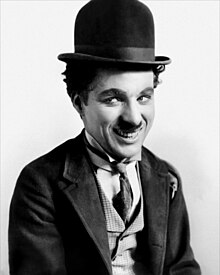Charlie Chaplin filmography

Charlie Chaplin in his “Tramp” persona
Charlie Chaplin (1889–1977) was a British film actor, comedian, director, producer, writer, musician and music composer whose work in motion pictures spanned from 1914 until 1967. During his early years in film he became established as a worldwide cinematic idol renowned for his tramp persona. During the 1910s and 1920s he was considered the most famous person on the planet.
Chaplin was born in London and began acting on stage at the age of nine.[2] In 1913, while on tour in the United States with Fred Karno’s comedy group, he accepted a contract to work for Mack Sennett’s Keystone film company. During his time at Keystone he began writing and directing some of the films in which he starred. Chaplin signed with the Essanay Film Manufacturing Company in 1915 and the year after with the Mutual Film Corporation. In 1918 Chaplin began producing his own films, initially releasing them through First National and then through United Artists, a corporation he co-founded with Mary Pickford, Douglas Fairbanks, and D. W. Griffith.[3] In the late 1940s and early 1950s Chaplin was accused of being a Communist sympathizer, which he denied.[4] He remained a British subject and, while travelling to England in 1952 to attend the premiere of his film, Limelight, his American re-entry permit was rescinded.[5] Chaplin eventually settled in Switzerland, where he remained for the rest of his life. He made his last two films in England.
During his lifetime Chaplin received three awards from the Academy of Motion Picture Arts and Sciences. At the first Academy Awards ceremony, held on May 16, 1929, he won an honorary award for writing, directing, producing, and acting in The Circus (1928). In 1972 he returned to the United States after nearly two decades to receive another honorary award, this time for his overall achievements in cinema. The following year Chaplin’s score for Limelight received the Academy Award for Best Music. Although 20 years old by this time, Limelight had not been released in the Los Angeles area until 1972, and had not been eligible for Academy Award consideration before then. Chaplin also received Academy Award nominations in 1940 for Best Actor and Best Original Screenplay for The Great Dictator and in 1947 for his screenplay of Monsieur Verdoux.
As of 2011, six of the films Chaplin starred in have been added to the National Film Registry: The Immigrant (1917), The Kid (1921), The Gold Rush (1925), City Lights (1931), Modern Times (1936), and The Great Dictator (1940). Also selected was Show People (1928), which features Chaplin in an unbilled cameo appearance.[8] For his work in motion pictures, Chaplin has a star on the Hollywood Walk of Fame.
source : wikepedia

